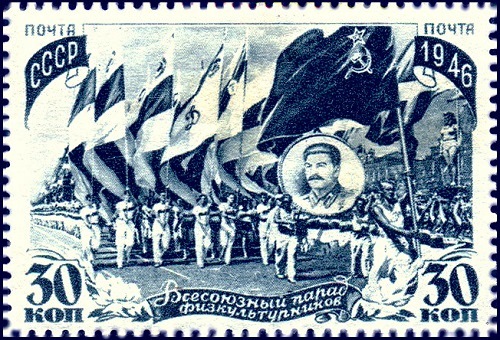The stamps of Soviet Russia have special fascinations. In the period after WWII, Russia was still under the rule of Josef Stalin. There is quite a historical debate over who was history’s greatest monster. Stalin may not rank number one in murders, but when it came to vindictiveness and pathological paranoid homicides, he would have to rank in first place. There were very few friends or allies that Stalin didn’t turn on and murder (Hitler was a monster, but at least Goebbels and Bormann liked him). Stalin’s purges fell on ethnicities (like the Georgians) and on his own political apparatus. Even stamp designers could be hauled off to Siberia or shot for “counter revolutionary” crimes such as not having enough smiling workers in a stamp they designed in the distant past. It is this terror of anything new—new colors, new feel or design, new themes—that is at the heart of Soviet stamp design in the immediate post-WWII period that preceded Stalin’s death in 1953.
 The designs are all the same and all knock offs of the prototypes from the earlier Soviet period. Smiling workers, busy factories, happy shoppers (with fantasy stocked shelves) all were the images that these postage stamps were trying to create. But life in post-WWII Russia was very hard. Most Westerners are familiar with how difficult things were in Western Europe after WWII. European Russia was at least as devastated as Germany. Russia lost nearly 30 million people (15% of their population while Germany lost 10% of hers). Hunger was rife in post-war Germany even with the benefit of the Marshall Plan. In the Soviet Union, there was devastation and starvation. Really one of the great economic success stories of the last century was how Russia, with an inefficient, centrally planned economy, fought her way from the rubble of 1945 to a world power by 1960.
The designs are all the same and all knock offs of the prototypes from the earlier Soviet period. Smiling workers, busy factories, happy shoppers (with fantasy stocked shelves) all were the images that these postage stamps were trying to create. But life in post-WWII Russia was very hard. Most Westerners are familiar with how difficult things were in Western Europe after WWII. European Russia was at least as devastated as Germany. Russia lost nearly 30 million people (15% of their population while Germany lost 10% of hers). Hunger was rife in post-war Germany even with the benefit of the Marshall Plan. In the Soviet Union, there was devastation and starvation. Really one of the great economic success stories of the last century was how Russia, with an inefficient, centrally planned economy, fought her way from the rubble of 1945 to a world power by 1960. The stamps of immediate post-WWII Europe have risen smartly in price over the last thirty years as the increasing affluent Western Europeans began to buy the stamps that they couldn’t afford when they were issued. The stamps of post-WWII Russia have risen in price too, but to nowhere what they should be worth. No one in Russia could afford these stamps when they were issued, and Americans, the only ones with money in the post-WWII period that we are talking about, soon found themselves at political odds with Russia and didn’t much care for the political hype of Russian stamps anyway. Russia doesn’t have a long philatelic tradition, and it is not currently a very wealthy country, but if stamps ever catch on there, the issues of 1945-1953 should prove to be woefully undervalued.
The stamps of immediate post-WWII Europe have risen smartly in price over the last thirty years as the increasing affluent Western Europeans began to buy the stamps that they couldn’t afford when they were issued. The stamps of post-WWII Russia have risen in price too, but to nowhere what they should be worth. No one in Russia could afford these stamps when they were issued, and Americans, the only ones with money in the post-WWII period that we are talking about, soon found themselves at political odds with Russia and didn’t much care for the political hype of Russian stamps anyway. Russia doesn’t have a long philatelic tradition, and it is not currently a very wealthy country, but if stamps ever catch on there, the issues of 1945-1953 should prove to be woefully undervalued.
